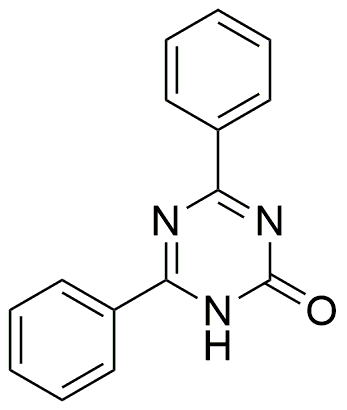4,6-Diphenyl-1,3,5-triazin-2(1H)-one is widely utilized in research focused on:
- Photovoltaic Applications: This compound is used in the development of organic solar cells, enhancing light absorption and energy conversion efficiency.
- Fluorescent Dyes: It serves as a key component in fluorescent dyes, which are essential for biological imaging and diagnostics in medical research.
- Polymer Chemistry: The compound is incorporated into polymers to improve thermal stability and UV resistance, making it valuable in the production of durable materials.
- Agricultural Chemicals: It is utilized in formulating agrochemicals, particularly as a photostabilizer for pesticides, extending their effectiveness under sunlight exposure.
- Analytical Chemistry: The compound is employed in various analytical methods, including chromatography, to separate and identify complex mixtures in environmental and food safety testing.
General Information
Properties
Safety and Regulations
Applications
4,6-Diphenyl-1,3,5-triazin-2(1H)-one is widely utilized in research focused on:
- Photovoltaic Applications: This compound is used in the development of organic solar cells, enhancing light absorption and energy conversion efficiency.
- Fluorescent Dyes: It serves as a key component in fluorescent dyes, which are essential for biological imaging and diagnostics in medical research.
- Polymer Chemistry: The compound is incorporated into polymers to improve thermal stability and UV resistance, making it valuable in the production of durable materials.
- Agricultural Chemicals: It is utilized in formulating agrochemicals, particularly as a photostabilizer for pesticides, extending their effectiveness under sunlight exposure.
- Analytical Chemistry: The compound is employed in various analytical methods, including chromatography, to separate and identify complex mixtures in environmental and food safety testing.
Documents
Safety Data Sheets (SDS)
The SDS provides comprehensive safety information on handling, storage, and disposal of the product.
Product Specification (PS)
The PS provides a comprehensive breakdown of the product’s properties, including chemical composition, physical state, purity, and storage requirements. It also details acceptable quality ranges and the product's intended applications.
Certificates of Analysis (COA)
Search for Certificates of Analysis (COA) by entering the products Lot Number. Lot and Batch Numbers can be found on a product’s label following the words ‘Lot’ or ‘Batch’.
*Catalog Number
*Lot Number
Certificates Of Origin (COO)
This COO confirms the country where the product was manufactured, and also details the materials and components used in it and whether it is derived from natural, synthetic, or other specific sources. This certificate may be required for customs, trade, and regulatory compliance.
*Catalog Number
*Lot Number
Safety Data Sheets (SDS)
The SDS provides comprehensive safety information on handling, storage, and disposal of the product.
DownloadProduct Specification (PS)
The PS provides a comprehensive breakdown of the product’s properties, including chemical composition, physical state, purity, and storage requirements. It also details acceptable quality ranges and the product's intended applications.
DownloadCertificates of Analysis (COA)
Search for Certificates of Analysis (COA) by entering the products Lot Number. Lot and Batch Numbers can be found on a product’s label following the words ‘Lot’ or ‘Batch’.
*Catalog Number
*Lot Number
Certificates Of Origin (COO)
This COO confirms the country where the product was manufactured, and also details the materials and components used in it and whether it is derived from natural, synthetic, or other specific sources. This certificate may be required for customs, trade, and regulatory compliance.


